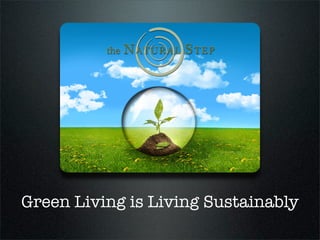Sustainability for students
- 1. Green Living is Living Sustainably
- 2. Sustainability Meeting the needs of the present without compromising the ability of future generations to meet their own needs.
- 5. Tip of the iceberg.
- 6. Real Cost of Goods Product Stewardship The Natural Step Framework
- 7. Not pictured: ŌĆórefrigerator-freezer ŌĆó camcorder ŌĆó woodworking tools ŌĆó computer ŌĆó glass butter’¼éy collection ŌĆó trampoline ŌĆó ’¼üshing equipment ŌĆó ri’¼ées for deer hunting ŌĆóamong other things Skeen Family - Pearland, Texas Photograph ┬® 2004 Peter Menzel/menzelphoto.com ItŌĆÖs all about Stuff.
- 8. The U.S. has 5% of the worldŌĆÖs population, but uses 30% of its resources.
- 9. The $ on the price tag re’¼éects direct costs -- labor & materials.
- 10. The $ on the price tag does NOT include the hidden costs.
- 11. It takes 1.8 tons of raw materialsŌĆöincluding fossil fuels, water and metal oresŌĆöto manufacture a desktop PC and monitor. Source: 2004 United Nations University Study [Smithsonian Magazine, August 2005]
- 12. ItŌĆÖs one thing to have all these hazardous materials in our computers. Source: Silicon Valley Toxics Coalition/Electronics Take Back Campaign, 2008 [ŌĆ£The Story of Stuff,ŌĆØ by Annie Leonard]
- 13. You should also look at how those chemicals are released into the environment ŌĆ”and into humans! Source: ŌĆ£The Story of Stuff,ŌĆØ by Annie Leonard
- 14. In 2006, one computer manufacturer received a high ranking in GreenpeaceŌĆÖs ŌĆ£Guide to Green Electronics.ŌĆØ Another study looked into their supply chain -- the manufacturers who supply the components that make up a computer -- in China, Mexico, the Philippines and Thailand. Source: ŌĆ£The Story of Stuff,ŌĆØ by Annie Leonard
- 15. ŌĆó working conditions that were dangerous, degrading and abusive ŌĆó excessive working hours and forced overtime ŌĆó illegally low wages and unpaid overtime The Chinese workers in this photo make 55┬ó an hour. ŌĆó and more. Source: Impact Lab, April 17, 2010 Source: ŌĆ£The Story of Stuff,ŌĆØ by Annie Leonard
- 16. Wenling, Zhejiang Province, China Source: Greenpeace.org Guiyu, China Source: Basel Action Network, 2008. Lastly, we must consider the disposal of computers and how they can continue to harm the environment. ŌĆ£The Story of Stuff,ŌĆØ by Annie Leonard
- 17. Graphic: California Product Stewardship Council Partial Solution: Product Stewardship
- 18. Developed in 1989, the TNS Framework builds on the basic understanding of what makes life possible, how our biosphere functions and how we are part of the earthŌĆÖs natural systems.
- 19. 1. Eliminate fossil fuel dependence and wasteful use of scarce metals and minerals. Reduce mining and use of substances from earthŌĆÖs crust: ŌĆó heavy metals such as cadmium, lead, mercury, ŌĆó minerals such as phosphorus ŌĆó fossil fuels Samarco Alegria Iron Ore mine in Brazil . Mining operations began in 1992. 8.5 million tons of iron ore was mined in 2008. These substances and their emissions (CO2 and NOx) are steadily increasing in human society and nature.
- 20. 2. Eliminate dependence upon persistent chemicals and wasteful use of synthetic substances. ŌĆó Humans are manufacturing synthetic substances faster than they can be broken down. ŌĆó EPA lists more than 70,000 chemicals that are in common use. ŌĆó Every U.S. citizenŌĆÖs fatty tissue contains at least 700 chemical contaminants, according to EPA.
- 21. 3. Eliminate encroachment upon nature ŌĆō land, water, wildlife, forests, soil, ecosystems. ŌĆó Human activity is breaking down natural systems faster than they can renew themselves. ŌĆó Nearly one-half of the EarthŌĆÖs original forest cover has been lost. ŌĆó Demand for fresh water exceeds the worldŌĆÖs supply by 17 percent.
- 22. 4. Meet human needs fairly and ef’¼üciently. ŌĆó If people around the world cannot meet their basic human needs (air, water, food, shelter), the ’¼ürst three system conditions will not be met. ŌĆó Within our businesses & communities, our needs include: ŌĆó a means of a livelihood ŌĆó mobility ŌĆó equal treatment ŌĆó equal access ŌĆó participation in decisions ŌĆó safety ŌĆó right to peaceful enjoyment of life ŌĆó connection with nature
- 23. Real Cost of Goods Product Stewardship The Natural Step Framework
- 24. Learn More ŌĆ£The Story of StuffŌĆØ by Annie Leonard ŌĆ£Cradle to CradleŌĆØ by William McDonough & Michael Braungart ŌĆ£Af’¼éuenza: The All-Consuming EpidemicŌĆØ by John De Graff, David Wann & Thomas H. Naylor ŌĆ£Exposed: The Toxic Chemistry of Everyday Products and WhatŌĆÖs at Stake for American PowerŌĆØ by Mark Schapiro ŌĆ£Confessions of an Eco-Sinner: Tracking Down the Sources of My StuffŌĆØ by Fred Pearce
- 25. Lori De La Cruz, ABC Principal Blue Marble Media, LLC www.BlueMarbleMedia.net











![It takes 1.8 tons of raw materialsŌĆöincluding fossil
fuels, water and metal oresŌĆöto manufacture a desktop
PC and monitor.
Source: 2004 United Nations University Study [Smithsonian Magazine, August 2005]](https://image.slidesharecdn.com/sustainabilityforstudents-100623092128-phpapp02/85/Sustainability-for-students-11-320.jpg)
![ItŌĆÖs one thing to have all these hazardous
materials in our computers.
Source: Silicon Valley Toxics Coalition/Electronics Take Back Campaign, 2008 [ŌĆ£The Story of Stuff,ŌĆØ
by Annie Leonard]](https://image.slidesharecdn.com/sustainabilityforstudents-100623092128-phpapp02/85/Sustainability-for-students-12-320.jpg)












